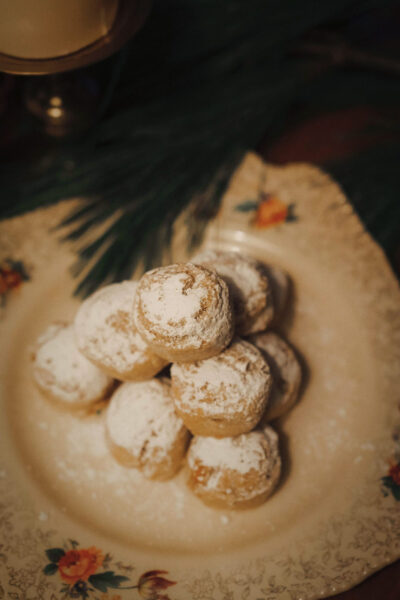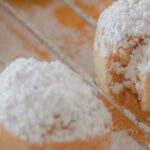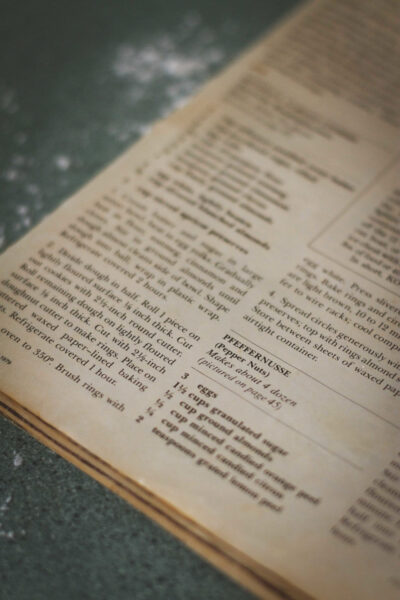This post was created for our 2021 Holiday Pops. The recipe is so good, we couldn’t help but share it again!
Christmas is all about the music…but its really all about the baking!
 Our Holiday Pops concert this year is special – its the first time we’ll have the full orchestra for our annual festive show in two years…so it feels like we’ve got everyone home for the holidays. It’s going to be a night filled with festive joy.
Our Holiday Pops concert this year is special – its the first time we’ll have the full orchestra for our annual festive show in two years…so it feels like we’ve got everyone home for the holidays. It’s going to be a night filled with festive joy.
Last year we decided we would invite ourselves into the kitchen’s of our Principal Bassoonist and Director of Administration for some cookies and toffee, and this year we wanted to try something traditional. Margaret Wilson, the SSO’s Principal Clarinetist, had a family tradition of making pfeffernusse for Christmas and it seemed perfectly fitting for a Holiday Pops that feels like a family homecoming.
Margaret is no stranger to our annual Holiday Pops as she’s been our Principal Clarinetist for 45 seasons! To hear how excited she is for these new arrangements by Maria Fuller means that the concert is a festive treat.
Pfeffernusse is a traditional German cookie that is just the right blend of savory and a touch of sweet. They date all the way back to 1753 and have been part of Yuletide celebrations in Germany since 1850!
There’s even wonderful stories about the composer Felix Mendelssohn traveling a good distance just to get Pfeffernusse, writing: “I can’t conduct the Düsseldorf Music Festival because I have to rest and move to Soden, I’m going to Offenbach with Ms. Bernus to buy Pfeffernüsse.”
Let’s get started!
 3 eggs
3 eggs- 1 1/2 cups sugar
- 1/2 cup ground almonds
- 3/4 cup minced candied peel
- 2 tsp. grated lemon peel
- 3 cups (approximately – probably less) all-purpose flour
- 1 tsp. cinnamon
- 1/4 tsp. ginger
- 1/2 tsp. ground pepper
- 1/8 tsp. ground cloves
- 1/4 cup rum or brandy
- powdered sugar
l. Beat eggs and sugar with electric mixer in large bowl until thick and lemon coloured. Stir in almonds, candied peel and grated lemon peel
2. Sift together approximately ll112 cups cups of flour with the cinnamon, ginger, pepper and cloves. Stir into egg mixture and keep adding more flour until dough almost cleans side of bowl.
3. Knead on lightly floured surface, adding as much flour as needed until smooth – about 1 minute.
4. Divide dough in half: shape each half into log 1 1/2 inches in diameter. Refrigerate wrapped in plastic wrap at least one hour.
5. Cut logs into 3/4 inch thick slices: round edges slightly. Place slices on greased or parchment lined baking sheets. Let stand at room temperature overnight.
6. Heat oven to 325 degrees. Turn cookies over. Bake until centres are firm to the touch and tops are golden – approximately 20 minutes.
7. Transfer to wire racks. Brush cookies generously with rum or brandy; sprinkle generously with powdered sugar. Cool completely. Texture and flavour improve if allowed to age in airtight container 1 to 2 weeks.
Margaret’s secret tip: Although the original recipe calls for the spices to be sifted into the 3 cups of flour, I have never been able to work in that much flour. That is why I put the spices into less flour to start and then work in as much flour as need – usually about 2 1/4 – 2 l/2 cups.
Time to get your baking hat on!
[youtube https://www.youtube.com/watch?v=fJrc2Yesn08]












 Now that we have an audience in the room it’s more important to us than ever that we keep our events covid free. Since Opening Night we’ve required that everyone, and we mean everyone, interacting with your orchestra is fully vaccinated. All our musicians, guest artists, staff, and volunteers have proven their vaccination status. Before your ticket is scanned there is a wonderful volunteer checking your vaccine status. Everyone in the room is wearing masks and we’ve encouraged you to spread out in our concert spaces to your comfort level.
Now that we have an audience in the room it’s more important to us than ever that we keep our events covid free. Since Opening Night we’ve required that everyone, and we mean everyone, interacting with your orchestra is fully vaccinated. All our musicians, guest artists, staff, and volunteers have proven their vaccination status. Before your ticket is scanned there is a wonderful volunteer checking your vaccine status. Everyone in the room is wearing masks and we’ve encouraged you to spread out in our concert spaces to your comfort level.
